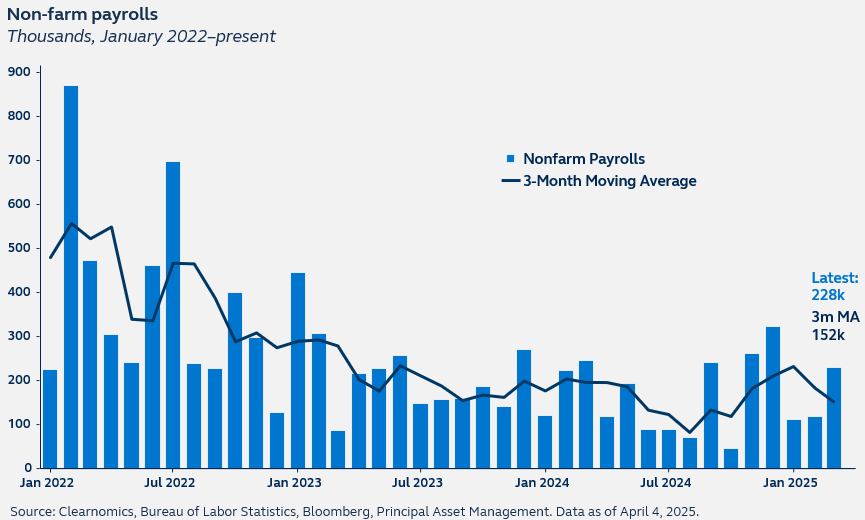US Jobs Report shows calm before the storm
The February jobs report showed a solid 228,000-worker boost in payrolls, well above consensus expectations, providing a partial offset to a week dominated by negative policy headlines. Hiring was boosted by a respite from a cold winter, while layoffs have yet to pick up meaningfully. Today’s jobs data, however, may already be stale, as economic headwinds are intensifying amid federal government layoffs, and now, trade-related uncertainty.

Report details
- Total non-farm payrolls increased by 228,000 in March, well above expectations and stronger than last month’s (downwardly revised) 117,000 gain. Consensus had called for 140,000 payrolls, so today’s solid upward surprise is a reprieve for markets in a week dominated by negative policy headlines.
- Overall job growth was driven by a mix of cyclical and structural industries, including healthcare, retailing, and transportation & warehousing, which added 54,000, 24,000, and 23,000 workers, respectively. Contributing to the boost in retail employment was the return of striking workers in the food and beverage sector. Weather-sensitive industries, such as leisure & hospitality also saw a rebound in jobs, gaining 43,000, following the colder-than-usual winter.
- Meanwhile, federal government employment marked a second consecutive month of declines, losing 4,000 jobs tied to DOGE-related job cuts. However, this was largely offset by continued gains within state and local government hiring. The BLS counts workers on paid leave or ongoing severance or leave as employed, suggesting the fallout from federal government layoffs may not materialize for a few more months.
- The unemployment rate unexpectedly rose to 4.2%, from 4.1% prior, but this was largely driven by new entrants to the labor market, marked by a rise in the labor force participation rate, which ticked up to 62.5%, from 62.4% prior. While layoffs were subdued during the month, the labor market remains in an uneasy equilibrium—low layoffs coupled with low hirings—suggesting that there is still a risk that only a mild pick up in layoffs is needed to see the unemployment rate rise.
- Average hourly earnings rose 0.3% in March, which was in line with expectations but slightly higher compared to last month’s (downwardly revised) 0.2% increase. This brings the annual rate to 3.8%, which is likely to continue to slow as both labor demand wanes and rising uncertainty lead to fewer workers quitting in search of higher pay.
Policy outlook
The stronger-than-expected March payrolls report may have offered markets a brief sense of relief after a week dominated by negative trade headlines. It’s reassuring, to a degree, that the labor market was on solid footing heading the current tariff-policy-induced shock. That may help cushion the slowdown—but only to a point.
Many investors are already wondering if this may be the last strong jobs report for a while. DOGE-related job cuts, for instance, have not yet shown up meaningfully in the data. Meanwhile, growing uncertainty is leading fewer workers to voluntarily leave jobs in search of better pay—a shift that could put downward pressure on wage growth. The hard payrolls data still reflects employment conditions before the trade-related uncertainty began to rachet higher. That’s likely to change in next month’s report, which may start to align more closely with the warning signs that the soft data are signaling.
The Fed is unlikely to read too much into the strength of this month’s jobs report, as policymakers probably see it as outdated in the context of the rapidly changing outlook. While the Fed appears poised to deliver support, their ability to offset the damage may be limited. Since the market is experiencing a government-driven shock, and not a central-bank one, the Fed can help sooth pain around the edges, but lingering inflation risks will constrain how much stimulus it can provide.

